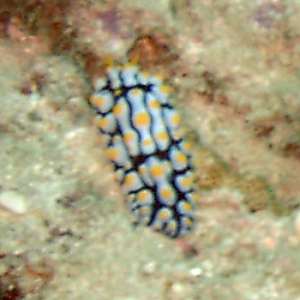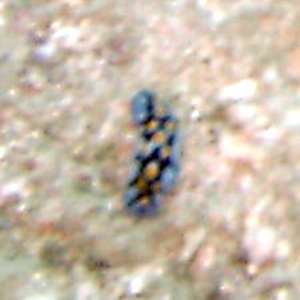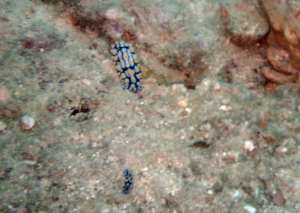Thai fried egg nudibranch?
March 16, 2005
From: Alyson Browett


I learned about nudibranchs from a couple I met on my way home from Costa Rica in 2002 -- too late to search for them while diving.
However, while in Koh Tao, Thailand, in mid-July 2004, I spotted two at about 10-15 meters depth. Koh Tao is in the Gulf of Thailand, and we were about 200 meters from shore. My husband, trying out underwater photography for the first time, got a minimally recognizable shot (attached).
I began calling them fried egg nudibranchs without knowing anything about them. I just came across your site while searching for information on nudibranchs, and I have to say that this is one of the best sites on the Web (and I design information Web sites for a living).
Locality: Koh Tao, Thailand, Gulf of Thailand. Depth: 10-15 meters. Length: large: 6 in. small: 3 in. 21 July 2004 reef. Photographer: John Ralph
I'm interested in knowing any more information about my fried egg nudibranchs!
Thanks,
Alyson Browett
Purcellville, VA, USA
browetta@advisory.com
Browett, A.M., 2005 (Mar 16) Thai fried egg nudibranch?. [Message in] Sea Slug Forum. Australian Museum, Sydney. Available from http://www.seaslugforum.net/find/13341
Dear Alyson,
Your two animals are phyllidiid nudibranchs - and both have a 'fried egg' colour pattern.. The larger is Phyllidia varicosa and the smaller one is, I think, Fryeria menindie. You can find more about the individual species on their respective Fact Sheets and accompanying messages. One interesting point your photo illustrates is that during the day, the phyllidiids are almost the only sea slugs which show themselves out on the reef. They are well protected from possible fish attack by very noxious chemicals they store in small glands in their skin, which they obtain from the sponges they feed on. There is a whole field of natural products chemistry which has built up to study the way animals have evolved the ability to make defensive chemicals and for others to steal them for re-use. The impetus for the research is not so much because of an seoteric interest in this field of evolution, but because these powerful molecules may turn out to cure some nasty human ailment.
Glad you like the site. We are in the middle of an upgrade at the moment - hopefully when I get some time I will put in some guides to make it easier for novices to do some self identification - or at least get down to a family grouping.
Best wishes,
Bill Rudman
Related messages
-
Phyllidia varicosa from Egypt
From: Eddy Mannak, April 21, 2008 -
Re: Phyllidia madangensis? from New Caledonia
From: Jean-François Hervé, March 28, 2008 -
Phyllidia varicosa from Mozambique
From: David Abecasis, March 7, 2008 -
Phyllidia varicosa from Tofo, Mozambique
From: Natasja Vandeperre, August 22, 2007 -
Phyllidia varicosa spawn from rodrigues island
From: Philibert Bidgrain, July 16, 2007 -
My first nudi photo
From: Simon Lavers, March 29, 2007 -
Phyllidia varicosa from the Great Barrier Reef
From: Andrew Trevor-Jones, September 5, 2006 -
Phyllidia varicosa from southern Egypt
From: Kamal El Tawil, September 12, 2005 -
Phyllidia varicosa from the Maldives
From: Charles Rowe, May 27, 2005 -
Phyllidia varicosa from Sth Africa
From: Charles Rowe, February 6, 2004 -
Slug id and is it reef safe.
From: Terry Moore, December 12, 2003 -
Phyllidia varicosa from Malaysia
From: Asther M. Lau, October 12, 2003 -
White Phyllidia varicosa? from Burma
From: Mary Jane Adams, March 24, 2003 -
Phyllidia varicosa mating
From: Mary Jane Adams, March 24, 2003 -
Phyllidia varicosa from Mozambique
From: Rudolph van Jaarsveld, March 13, 2003 -
Phyllidia varicosa from Pemba
From: Paul Young, November 25, 2002 -
Phyllidia varicosa from Tioman, Malaysia
From: Maliza Anuar, July 17, 2002 -
Giant size Phyllidia varicosa
From: Valda Fraser, June 28, 2002 -
Phyllidia varicosa from west Malaysia
From: Kheong Sann Chan, June 24, 2002 -
Photos of Phyllidia varicosa in aquarium
From: Jeff Lockwood, May 13, 2002 -
Phyllidia varicosa, dying?
From: Jeff Lockwood, May 11, 2002 -
Phyllidia varicosa from Malaysia
From: Kheong Sann Chan, April 21, 2002 -
So this must by Phyllidia varicosa!
From: Des Paroz, October 11, 2001 -
Phyllidia varicosa on crocodile fish
From: Mary Jane Adams , September 3, 2001 -
Phyllidia varicosa from Exmouth, W.A.
From: Kirk Gibson, April 12, 2001 -
Phyllidia varicosa from Madagascar
From: Leif Abrell, January 26, 2001 -
Phyllidia varicosa? from Thailand
From: Dave Harasti, January 10, 2001 -
Unknown Phyllidiid from Solomon Ids
From: Mary Jane Adams, January 5, 2001 -
Phyllidia varicosa from Indonesia
From: Yasman, December 23, 2000 -
Phyllidia varicosa in an aquarium
From: Christopher Shaw, September 23, 2000 -
Ecology of Phyllidia varicosa
From: Yasman, July 27, 2000 -
Phyllidia varicosa from South Africa
From: Valda Fraser, March 24, 2000 -
Re: Bob Bolland's phyllidiid
From: Bill Rudman., January 23, 2000 -
Okinawa Phyllidiid
From: Robert F. Bolland, January 8, 2000 -
Parasite? on Phyllidia
From: Erwin Koehler, October 3, 1999 -
Can I keep phyllidiids in the aquarium?
From: Rob See, January 4, 1999
